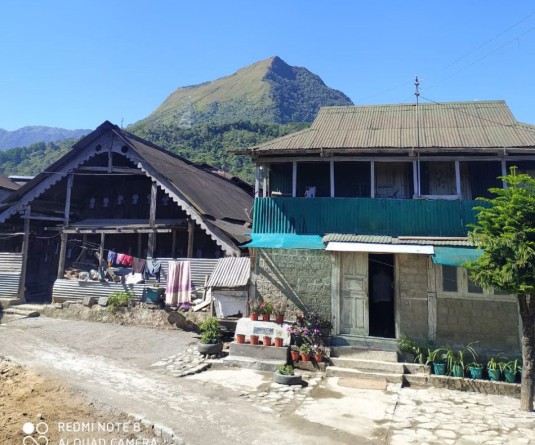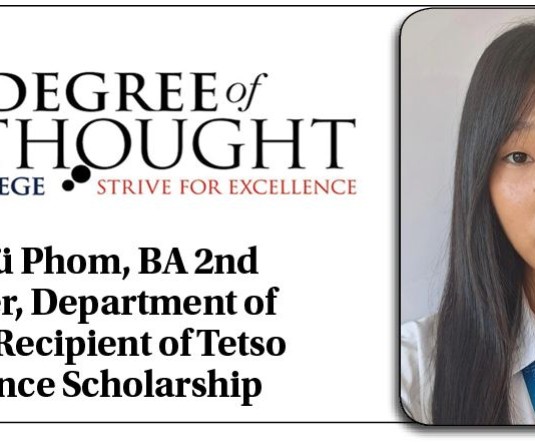
Part 1
The Performance and Politics of Culture in Nagaland, Northeast India
Dr Arkotong Longkumer
From the vantage point of the tribal Naga Kachari morung (traditional youth dormitory), I am mesmerised by the vivid colours of the different tribal attire. I hear myriad voices as throngs of people huddle around cackling bonfires with their bamboo jugs of hot tea and rice-beer, as dusk brings the unwelcome December winter chill in Kisama. It’s the end of the first day of Hornbill Festival 2012. Just above me, amidst the orange glow of the evening sun, the white letters ‘Naga Heritage Village’, a copy of the iconic ‘Hollywood’ sign, are faintly visible in contrast to the faded green of the hillside. On the hilltop a familiar Christian cross was foisted, I was told, to remind people that this is Nagaland, and like in most Naga villages, it is a central symbol: of Christ as redeemer.
Every year, thousands of tourists come to Kisama, also known as the ‘Naga Heritage Village’, located on the outskirts of Kohima, the capital of the Indian state of Nagaland. Bordering Burma and close to the Chinese border, little is known about Nagaland or even Northeast India, but tourists flock to this winter habitat to celebrate the now-famous week long Hornbill Festival, named after the endangered indigenous Hornbill bird of Nagaland. The Festival begins annually on the 1st of December that coincides with the inauguration of Nagaland, in 1963, as a state within the Indian Republic. The Festival is primarily a cultural performance that showcases the traditions and customs of the seventeen Naga tribes of the state of Nagaland. Each Naga ‘tribe’ has constructed a traditional morung that represent their unique tribal identity, with art skilfully carved onto outside wooden poles.
Each tribal morung is arranged according to the geographic map of their location within Nagaland. During the course of the Festival they entertain various visitors in their morung by performing their songs and dances, and exhibiting the different material culture. The Festival over the years has mushroomed into a mega state event that includes stalls that sell food, clothes and artefacts encouraging local, regional and national entrepreneurs to participate; it also hosts a number of indigenous games like Naga acrobatics, pig-chasing,and Naga chilli (the hottest in the world!) eating competition. It has introduced Rock, Fashion and Art shows and a bizarre World War II car rally that is an attempt to cater to a variety of audiences both within and outside Nagaland.
Access to Nagaland has been difficult primarily due to the fifty-year-old independence struggle with the Indian state. The peace process between these groups and the Indian state in 1997 ushered in relative calm, making travel and tourism easier. However, ‘official’ access to this region is still enforced in the form of the Restricted Area Permits (RAP) for foreigners and the Inner Line Permits (ILP) for Indian citizens outwith Nagaland and Northeast India.In 2011 the RAP was lifted while the ILP remains. Some Indian citizens I met from the Indian states of Uttar Pradesh and Maharashtra were irked by this duplicity that denies them access to regions within their own country. As a sign of protest they have ‘infiltrated’ Nagaland without ILPs.
The panoply of tourists, mixed with local participants, represents the sea of humanity.
Speaking and interacting with various people gives me a sense of the truly global dimension to the Festival that has grown in leaps and bounds from its earlier conception. Its origins coincided with the International year of the World’s Indigenous People in 1993.It was called ‘Naga week’ and held between 1st-5th of December in the local Kohima ground, organised by the Naga Peoples Movement for Human Rights (NPMHR) and the Naga Students Federation (NSF). ‘It was a difficult time for us’, reflected Neingulo Krome of NPMHR because factional clashes between the two NSCNs, along with Indian Army operations made the situation very tense ‘on the ground’. Using the slogan and rhetoric of the ‘world’s indigenous peoples’ year’, the NPMHR and the NSF appealed to the two NSCNs to cease fighting. Calm pervaded throughout the week when around twenty-seven Naga tribes from the Indian states of Nagaland, Assam, Manipur and even Burma came and constructed their morungs and celebrated their ‘indigenous’ cultures, creating a momentary safe space where they could come as ‘one’ Naga nation. For Neingulo, this was a ‘real’ celebration of indigenous Naga culture because there was a spirit of solidarity, amidst the chaos and violence that encouraged cooperation between different Nagas from all over. He laments that the Hornbill Festival in its current avatar is a poor imitation of the 1993 event. He says that the Government of Nagaland has made it into a commercial ‘state’ Festival that involves only its official seventeen Naga tribes. Many people I spoke to seem to agree with this sentiment. In fact, two officers from the tourism industry tell me separately that the Festival is about ‘selling’ Nagaland to the outside world.
They say that the success of the Festival is down to the presence of international tourists who come with cameras and are busy interacting with the various Naga troupes of performers. In fact, I do notice the active (and sometimes aggressive!) camera flashes are from their lenses. (Picture).
Most international tourists come to the Festival as ‘cultural tourists’ who frequent Festivals in many indigenous hotspots. One couple from Germany tell me they recently attended a similar festival in Papua New Guinea and heard about the Hornbill on their way to Bhutan. Such cosmopolitan tourists makeup the majority of those who come to Nagaland. I interact with four of them from England. Johnny and Sabina weren’t sure if the ‘Nagas’ were ‘Indians’ – they said that Nagaland feels more like Southeast Asia. For Johnny the Hornbill Festival represents the expression of an ‘authentic Naga national identity’. He is particularly impressed by the parade of bagpipes and drums with its accompanying material accoutrements. Perhaps this is a nostalgic reminder of Britain’s colonial rule? Indeed, the odd conflation of tartans kilts amidst the sea of Naga traditional clothes makes the event slightly bizarre if not mildly entertaining. Sabina is more critical. Having lived in Northern Thailand, where similar festivals were common, she observes that whereas in Thailand it was less organised and more spontaneous, the Hornbill was highly choreographed and managed. It gives one the impression that it is more of a ‘show’, than a ‘genuine’ Naga festival. Haley agrees. She contrasts the Hornbill Festival with those of neighbouring Garo and Khasi tribal festivals that were more ‘genuine’. Mike is more academic in his approach and says that he really enjoyed the Hornbill and this is the ‘real deal’. He is wary of comments of ‘authenticity’ – which authority decides its criteria? He is unequivocal in his stance that if the Nagas say that they are attempting to preserve and display ‘authentic’ Naga culture than who are we to say otherwise?
(Arkotong Longkumer is Lecturer at the University of Edinburgh, UK, interested in the interaction between anthropology and history. Currently he is working on a project that examines national identity in the Naga context but also more broadly in South and Southeast Asia. Feedback email: a.longkumer@ed.ac.uk)
The article is a republished piece from the South Asianist Blog (http://thesouthasianistblog.co.uk)
Who sings for the Hornbill?: PART II






